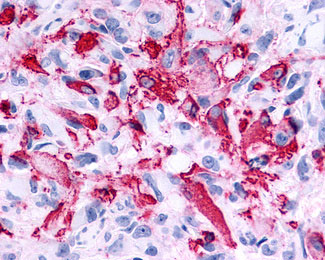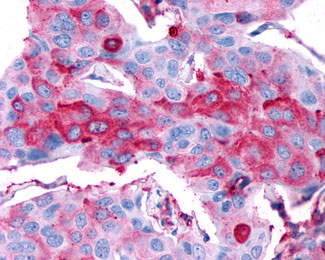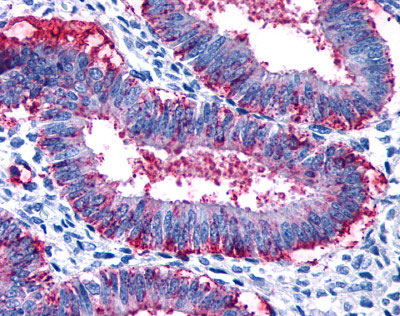RXFP2 / LGR8 Antibody (Cytoplasmic Domain)
Rabbit Polyclonal Antibody
- SPECIFICATION
- CITATIONS
- PROTOCOLS
- BACKGROUND

Application
| WB, IHC-P |
|---|---|
| Primary Accession | Q8WXD0 |
| Reactivity | Human, Horse |
| Host | Rabbit |
| Clonality | Polyclonal |
| Calculated MW | 86kDa |
| Dilution | IHC-P (26-130 µg/ml) |
| Gene ID | 122042 |
|---|---|
| Other Names | Relaxin receptor 2, G-protein coupled receptor 106, G-protein coupled receptor affecting testicular descent, Leucine-rich repeat-containing G-protein coupled receptor 8, Relaxin family peptide receptor 2, RXFP2, GPR106, GREAT, LGR8 |
| Target/Specificity | Human RXFP2. BLAST analysis of the peptide immunogen showed no homology with other human proteins. |
| Reconstitution & Storage | Long term: -70°C; Short term: +4°C |
| Precautions | RXFP2 / LGR8 Antibody (Cytoplasmic Domain) is for research use only and not for use in diagnostic or therapeutic procedures. |
| Name | RXFP2 |
|---|---|
| Synonyms | GPR106, GREAT, LGR8 |
| Function | Receptor for relaxin. The activity of this receptor is mediated by G proteins leading to stimulation of adenylate cyclase and an increase of cAMP. May also be a receptor for Leydig insulin-like peptide (INSL3). |
| Cellular Location | Cell membrane; Multi-pass membrane protein. |
| Tissue Location | Expressed mainly in the brain, kidney, muscle, testis, thyroid, uterus, peripheral blood cells and bone marrow |
| Volume | 50 µl |

Thousands of laboratories across the world have published research that depended on the performance of antibodies from Abcepta to advance their research. Check out links to articles that cite our products in major peer-reviewed journals, organized by research category.
info@abcepta.com, and receive a free "I Love Antibodies" mug.
Provided below are standard protocols that you may find useful for product applications.
Background
Receptor for relaxin. The activity of this receptor is mediated by G proteins leading to stimulation of adenylate cyclase and an increase of cAMP. May also be a receptor for Leydig insulin-like peptide (INSL3).
References
Hsu S.Y.,et al.Science 295:671-674(2002).
Gorlov I.P.,et al.Hum. Mol. Genet. 11:2309-2318(2002).
Muda M.,et al.Mol. Hum. Reprod. 11:591-600(2005).
Dunham A.,et al.Nature 428:522-528(2004).
Mural R.J.,et al.Submitted (JUL-2005) to the EMBL/GenBank/DDBJ databases.
If you have used an Abcepta product and would like to share how it has performed, please click on the "Submit Review" button and provide the requested information. Our staff will examine and post your review and contact you if needed.
If you have any additional inquiries please email technical services at tech@abcepta.com.













 Foundational characteristics of cancer include proliferation, angiogenesis, migration, evasion of apoptosis, and cellular immortality. Find key markers for these cellular processes and antibodies to detect them.
Foundational characteristics of cancer include proliferation, angiogenesis, migration, evasion of apoptosis, and cellular immortality. Find key markers for these cellular processes and antibodies to detect them. The SUMOplot™ Analysis Program predicts and scores sumoylation sites in your protein. SUMOylation is a post-translational modification involved in various cellular processes, such as nuclear-cytosolic transport, transcriptional regulation, apoptosis, protein stability, response to stress, and progression through the cell cycle.
The SUMOplot™ Analysis Program predicts and scores sumoylation sites in your protein. SUMOylation is a post-translational modification involved in various cellular processes, such as nuclear-cytosolic transport, transcriptional regulation, apoptosis, protein stability, response to stress, and progression through the cell cycle. The Autophagy Receptor Motif Plotter predicts and scores autophagy receptor binding sites in your protein. Identifying proteins connected to this pathway is critical to understanding the role of autophagy in physiological as well as pathological processes such as development, differentiation, neurodegenerative diseases, stress, infection, and cancer.
The Autophagy Receptor Motif Plotter predicts and scores autophagy receptor binding sites in your protein. Identifying proteins connected to this pathway is critical to understanding the role of autophagy in physiological as well as pathological processes such as development, differentiation, neurodegenerative diseases, stress, infection, and cancer.




